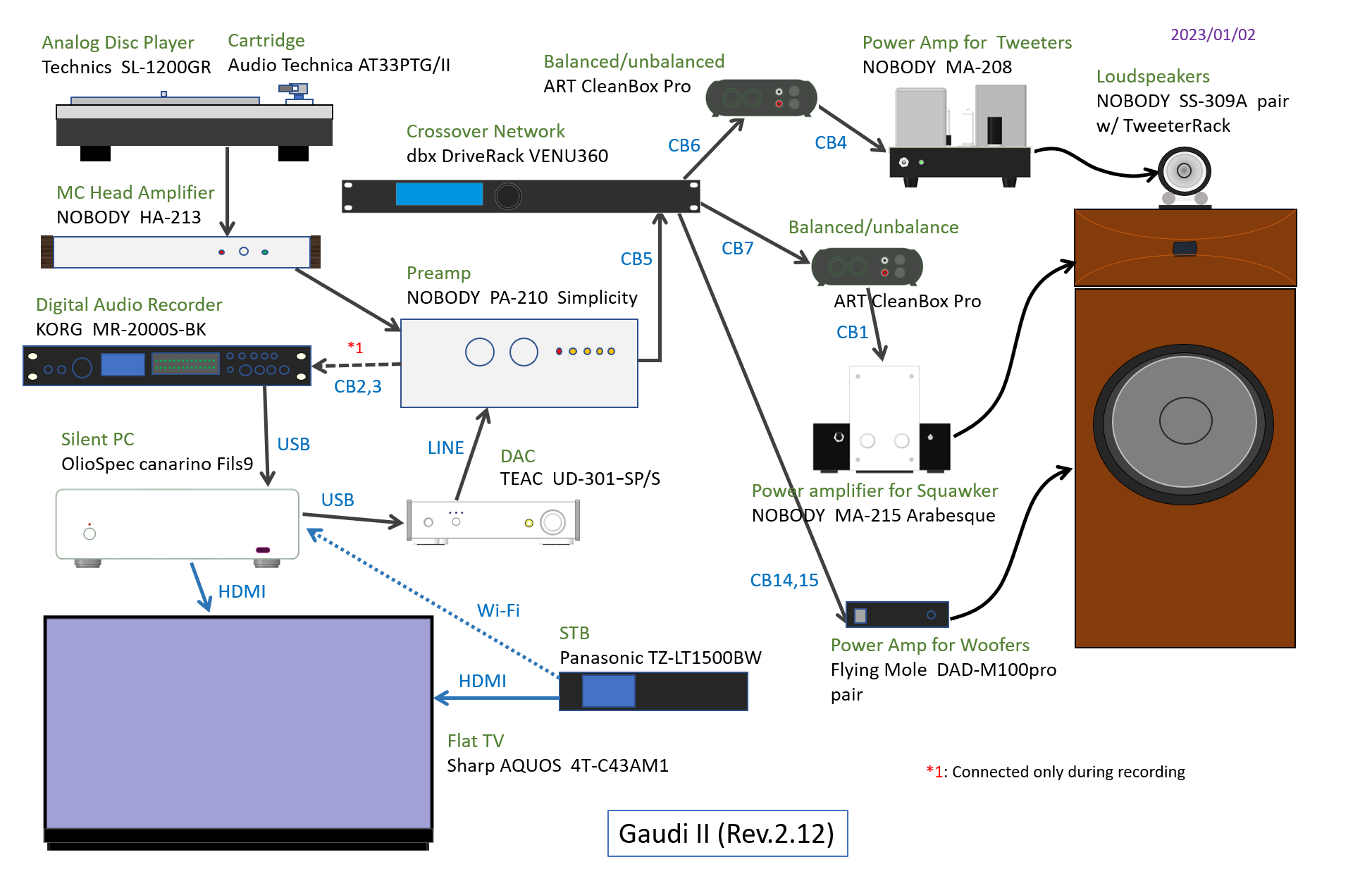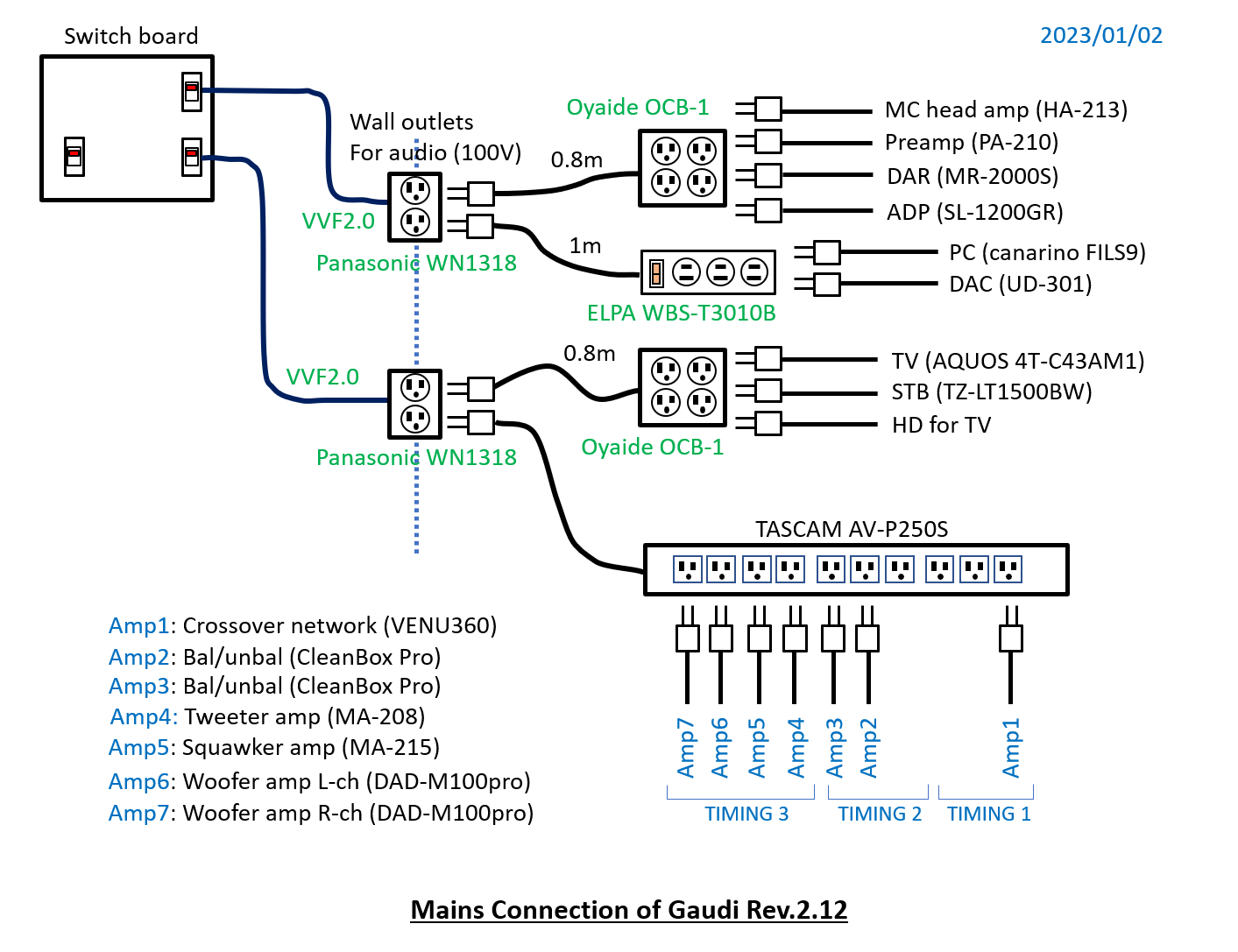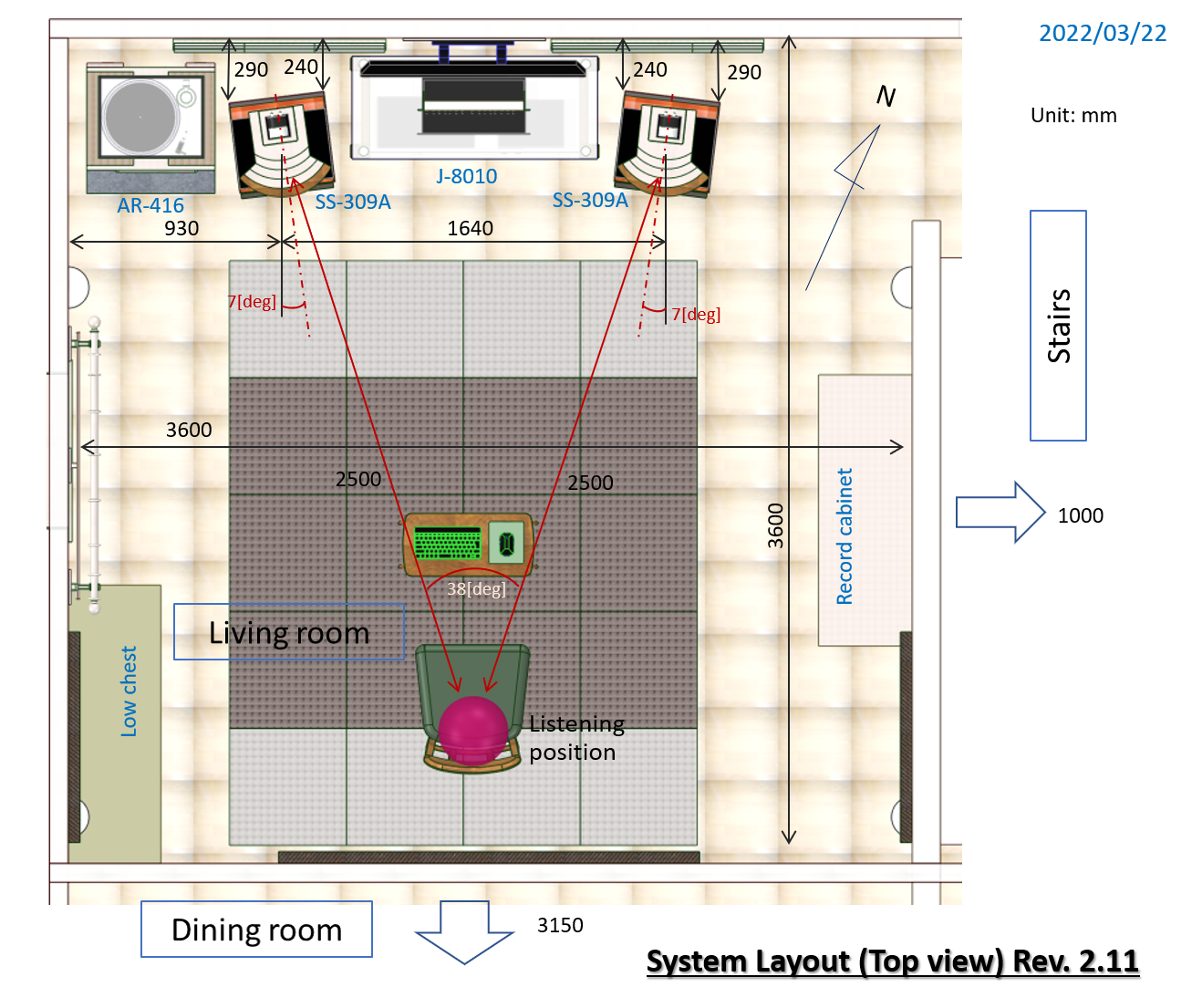Gaudi Rev.2.12
2018/12/29 created
2023/02/11 updated
Current revision of Gaudi II: Rev.2.12 (May 2022)
The problem that the squawker driver D1405 has uneven frequency response
surfaced in the previous revision (Rev.2.11). For the solution, I replaced the crossover network CX3400 with dbx DriveRack
VENU360, which is a digital type and has equalizer feature.
For the past revisions of Gaudi II, click here.
Configuration

I repleced the analog crossover network Behringer CX3400 with dbx DriveRack VENU360 (called VENU360).
VENU360 has equalizer feature. It can be used for compensation of the
uneven frequency response of D1405.
The outputs of VENU360 is balanced type (it doesn't have unbalanced outputs).
I employed balanced/unbalanced converter. I selected ARTcessories CleanBox Pro (CleanBox).
I use 2 units of CleanBox for MID and HIGH. LOW is directly connected to
the woofer amp without CleanBox, for my budget and the space for installation
are short.
The amplifiers are the old ones I used to use in the old Gaudi system (Ver.1).
I believe the amplifiers but the crossover network are not so influential
for the overall sound quality and functions. So I still use the old amps.
Layout

The component layout is as shown on the right (click to zoom up).
The position of VENU360 is the same as CX3400.
The two units of CleanBox are placed on each side of VENU360.
A in the previous revision (R2.11), the Tweeter Rack is place between the squawker horn and the tweeter. In the case that a digital crossover network is used, time alignment can be done without the Tweeter Rack, but I dare use it for better sound quality. For details, see the section "System-level Tuning" below.
The following figures show the layout of the whole system.
The difference from the previous revision is the distance between the loudspeakers
and the listening position. The previous one was 2.5m, nad the new one
is 3m. For details, see the section"System-level Tuning" below.
 |
 |
Cabling
The cables used in Gaudi R2.12 are as shown in the table below.
| From | To | RefDes *1 (model#) |
Wire | Length | Sender connector | Receiver connector | Note |
|---|---|---|---|---|---|---|---|
| ADP (SL-1200GR) |
MC head amp (HA-213) |
Low capacitance unbalanced wire (1-core shielded) |
1.5m | RCA plug | RCA plug | SL-1200GR's accessary Tied with earth wire Stereo pair | |
| MC head amp (HA-213) |
Preamp (PA-210) |
OFC balanced wire (2-core shielded) BELDEN 8412 |
1.5m | Teflon insulated RCA plug COLD-GND |
Teflon insulated RCA plug |
Unbalanced Stereo pair | |
| DAC (UD-301) |
Preamp (PA-210) |
4-core shielded wire Canare L-4E6S |
2m | RCA plug (Canare F-10) |
RCA plug (Canare F-10) COLD-GND |
Unbalanced Stereo pair | |
| Preamp (PA-210) |
DAR (MR-2000S) |
CB2 | 4-core shielded wire (Canare L-4E6S) |
2m | RCA plug (Canare F-10) |
RCA plug (Canare F-10) |
Unbalanced Stereo pair |
| DAR (MR-2000S) |
Preamp (PA-210) |
CB3 (Canare RC018) |
1-core shielded (Canare GS-6) |
1.8m | RCA plug (Canare F-10) |
RCA plug (Canare F-10) |
Unbalanced Stereo pair |
| Preamp (PA-210) |
Network (VENU360) |
CB5 (Canare RC03-B2) |
4-core shielded (Canare L-4E6S) |
3m | RCA plug (Canare F-10) |
XLR pulg COLD-GND |
Unbalanced Stereo pair |
| Network (VENU360) |
Bal/Unbal (CleanBox) |
CB6 (Canare EC01-B) |
4-core shielded (Canare L-4E6S) |
1m | XLR jack | XLR plug | Balanced Stereo pair |
| Bal/Unbal (CleanBox) |
Tweeter amp (MA-208) |
CB4 (Canare RC03) |
1-core shielded | 3m | RCA plug | RCA plug | Unbalanced Stereo pair |
| Network (VENU360) |
Bal/Unbal (CleanBox) |
CB7 (Canare EC01-B) |
4-core shielded (Canare L-4E6S) |
1m | XLR jack | XLR plug | Balanced Stereo pair |
| Bal/Unbal (CleanBox) |
Squawker amp (MA-215) |
CB1 | 4-core shielded (Canare L-4E6S) |
1.5m | RCA plug (Canare F-10) |
RCA plug (Canare F-10) |
Unbalanced Stereo pair |
| Network (VENU360) |
Woofer Amp (DAD-M100pro) |
CB14,15 (Classic Pro CXX050) |
2-core shielded | 1.5m | XLR jack | RCA plug (Canare F-09) |
Unbalanced Mono x2 |
| Tweeter amp (MA-208) |
Tweeter (T925A) |
OFC speaker cable Audio Technica AT365S |
2.8m | Directly soldered | w/o plug Titan oil applied |
||
| Squawker amp (MA-215) |
Squawker (D1405+H400) |
OFC speaker cable Audio Technica AT365S |
2.8m | Directly soldered | w/o plug Titan oil applied |
||
| Woofer Amp (DAD-M100pro) |
Woofer (FW305) |
0.65mm ETP copper single wire 47 Lab Stratos |
1.8m (Amp to woofer terminal) |
w/o plug Titan oil applied |
Directly soldered | Two wires twisted at 30cm pitch |
*1: The cables that are changed in Rev.2.12 are indicated in red. Some of
them are used in a different way from the system design.
For details, see the PDF below:
[Design document on line cables (LineCable_Design.pdf)]
AC Power Supply

The figure on the right shows the AC power connection (click to zoom up).
The difference between the previous revision and the current one is that VENU360 is connected to TIMING1 instead of CX3400 and CleanBox to TIMING2.
System-level Tuning
The system-level tuning was carried out as follows (the same as the previous
revision except adjust of PEQ):
- 1. Measurement of frequency response in quasi-anechoic method, and adjust of the gains of each band, plus compensation with PEQ
- 2. Measurement of the delay times of each band with one-cycle sine wave, and adjust of time alignment
- 3. Measurement of frequency response and waveforms at the listening position
- 4. Confirmation of sound quality by trial listening
It's necessary to repeat this sequence of the steps several times for fine tuning.
The initial settings of VENU360 is as follows:
- Configuration: stereo 3-way
- Crossover frequencies: fc1=900Hz, fc2=7kHz
- Filter type: 8th-order Butterworth (48dB/oct (BW48))
- Input gain: 0dB
- Limiter: off
- Phase: normal
- Time delay: 0msec
- Equalizer: GEQ: off, PEQ: off
- Infrasonic filter: 18Hz (BW12)
- Other settings: default
From here, the outputs of each band of VENU360 are denoted by LOW, MID,
HIGH.
The suffixes '-L' and '-R' denote the left and right channels, respectively
(e.g. LOW-L, MID-R).
Quasi-anechoic Measurement
This measurement was carried out according to the method specified in the
section "Loudspeaker Mesurement" - "Frequency Response"
of the supplemental information "Method 2: Measurement Methods".
The distance between the woofer and microphone in the near-field measurement
is d=13mm, and the merge frequency, fm=460Hz.
 | |
| Near-field measurement | Window width: -2.0 ~ +2.5msec |
Because the treble response of the squawker driver D1405 is poor, I use
PEQ (parametric equalizer) of MID to compensate it.
To flatten the frequency response, as much as +/- 5dB compensation is required.
But I found such big compensation will impair SQ. It's probably because
transient response is degraded.
I adjusted PEQ within +/-3dB range, though small undulation in frequency
response still remained.
The figure below shows the frequency response after the gains and PEQ were adjusted.

There are undesirable undulation around fc1 (=900Hz) and the dip below fc2 (=7kHz).
The response declines gradually below 60Hz. It's because the sound pressure
from the bass reflex duct was neglected in the quasi-anechoic measurement.
Many small peaks and dips are seen, but they aren't big enough to consider them to be resulted from comb filter effect. I think time alignment is established somehow. The more precise the tuning, the flatter the frequency response curve.
The settings of PEQ are shown in the figures below. The figures show only the settings of the left channel. The right channel is set up the same.
 |
 |
| PEQ of MID-L: -2.2dB @1kHz | PEQ of MID-L: +3.0dB @6.6kHz |
Time Alignment Adjustment
For details of time alignment adjustment, see the section "Time Alignment Adjustment" of the supplemental information "Method 2: Measurement Methods".
I couldn't adjust the timings precisely due to a ringing the squawker generated.
The figure below shows the squawker's ringing:

The woofer also generated ringing. But I think it is reasonable for its mass of the vibration system.

Time alignment of squawker and tweeter
It's hard to adjust the timing due to the ringing, but I did the best I
could.
The following figure shows the waveform at fc2.

Since squawker and tweeter are located at the same position on the z-axis
by using Tweeter Rack, the time delay feature of VENU360 was supposed to
be unnecessary. However, it is necessary for some reason. I placed tweeter
as backward as possible, but the timing wasn't aligned yet. I used the
delay feature for HIGH. Probably, the internal processing times in VENU360
are different between MID and HIGH.
Delay time of HIGH: L-ch: 0.1msec, R-ch: 0.44msec
Time alignment of squawker and woofer
It's hard to adjust the timing due to the ringing, but I did the best I
could.
The following figure shows the waveform at fc1.

I don't know why, but the timings were aligned without the time delay feature of VENU360.
Delay time of LOW: L-ch: 0.0msec, R-ch: 0.0msec
Characteristics at Listening Position
The chart below shows the frequency response at the listening position after the system-level tuning.

The decline in the 1.3kHz to 6kHz range is almost the same curve as in
the quasi-anechoic measurement. As told above, the curve can be flattened
by increasing the boost with the PEQ, but it will even impair SQ. I am
planning to investigate this problem further in the future project (SS-309B).
Unlike the quasi-anechoic measurement, the response declines as the frequency
reduces in 130Hz to 1.3kHz range. I don't know the reason.
I'm not convinced that the response declines also at frequencies below
60Hz. I expected the bass response would be boosted by the floor and walls
, but it didn't happen.
The resonance frequency of the duct is 26Hz, and the small peak is seen
at the frequency. Though the bass reflex system works, the response the
region between 30Hz and 44Hz is poor, so I feel deep bass is not enough.
The curve of the left channel is so rough in the 30Hz-150Hz band. This
is caused by the audio rack (AR-416 Air) near the left speaker. Kinglet
system, where the steel rack with my old devices like MA-201 and PS-104
in it is located near the right speaker, exhibits the same characteristics.
The racks bring about a "bumpy" curve in bass region.
I once wrote that an audio rack situated on the corner of the room works
as a "diffuser" and may improve SQ. Now I know it is wrong. I
withdraw this theory.
The frequency response curve is uneven due to comb filter effect, though, I don't think it's caused by bad time alignment. It's probably caused by the standing waves in the room, because the response isn't so uneven in the quasi-anechoic measurement.
The frequency response is far from good one, but it's not so bad to my
ears.
We humans have a complex perception mechanism, and can't perceive the vibration
of the eardrum itself. We learn the room acoustics unconsciously, and compensate
the input signals from the ear so that the sensed sound becomes nearly
the original sound, as if we have a strong equalizer in our brains. So,
I believe, the perceived frequency response is nearer the one in the quasi-anechoic
measurement than the real frequency response.
Though the quasi-anechoic frequency response is not even either, only the
high treble is reduced. I don't feel the tone is unnatural.
Trial Listening
I did trial listening each time I changed the settings VENU360 by playing the album for loudspeaker set-up, 2xHD "Audiophile Speaker Set-up". The format is DSD5.6M (DSD128). I mainly played performances of jazz combos with and without vocals in the album.
I realized something during the trial listenings that SQ got better when
moving the listening position further from the loudspeakers than the previous
layout. It might influence that the distance between tweeter and squawker
has been widened by using Tweeter Rack. The previous distance between the
loudspeaker and the listening position was 2.5m. I changed it to 3m.
Consequently, the angle of the loudspeakers has been narrowed to 31 degrees
from the previous 38 degrees. But there's no problem in stereo imaging.
If anything, I feel the sound stage is even wider than before since it
is deeper.
 |
 |
 |
| Layout in Rev.2.11 Loudspeaker ==> Listener: 2.5m Angle of loudspeakers: 38deg |
Layout in Rev.2.12 Loudspeaker ==> Listener: 3m Angle of loudspeakers: 31deg |
The Position of Tweeter
With a digital crossover network, it isn't necessary to place tweeter just
above the squawker driver for time alignment. I started the tuning with
tweeter placed at the same position as in Rev.2.1.
However, SS-309A sounded somewhat uncomfortably. I tried placing tweeter
at the same position as in Rev.2.11, then SQ became satisfactory.
I think the distance on y-axis (vertical) between tweeter and squawker
affects SQ more than time alignment.
This tentative theory may be a deep problem. I will scrutinize it in the
next project.
I chose the position of Rev.2.11 this time.
Final Settings of VENU360
After tuning and trial listening, the settings of VENU360 turned out as follows:
- Configuration: stereo 3-way
- Crossover frequencies: fc1=900Hz, fc2=7kHz
- Filter type: 8th-order Butterworth (48dB/oct (BW48))
- Input gain: L-ch: -2.0dB, R-ch: 0dB
- Band gains: HIGHs: 2.0dB, MIDs: -8.5dB, LOWs: 0.0dB *1
- Limiter: off
- Phase: normal
- Time delay: HIGH-L: 0.1msec, HIGH-R: 0.44msec, MID-L: 0msec, MID-R: 0.52msec, LOW-L: 0.0msec, LOW-R: 0.0msec *2
- Equalizer: GEQ: off, PEQ: MID-L: -2.2dB @1kHz, +3.0dB @6.6kHz, MID-R: -2.2dB @1kHz, +3.0dB @6.6kHz
- Infrasonic filter: 18Hz (BW12)
- Other settings: default
*1: The attenuators of the power amps are also used for gain adjust.
*2: The tuning is not so precise because of the ringing of squawker.
Room Acoustics
The room acoustics hasn't been changed since Rev.2.03. I continued to use the acoustic goods I had employed for Gaudi with some exceptions.
Self-evaluation
By utilizing the various features of the digital crossover network, finer
system-level tuning could be done than the previous revision of Gaudi II.
The frequency response has been improved by using PEQ, and time alignment
has been taken with time delay feature.
These adjustments have improved SQ.
Sound Quality
As I always do, I continued to replay my favorite discs more than one month
to evaluate SQ of the new Gaudi II.
SQ has been improved to the level that I can say it is the best in Gaudi's
history.
My friends also said it was the best.
There is one catch, though, woofers emit some noise. And, the level of
the noise is pretty high. This noise is caused by the RF noise that comes
from VENU360.
I solved this problem by turning down the attenuators of the woofer amps.
I have been troubled for many years that the sound of piano didn't sound like a real piano. But this problem has been solved. The reberbation of the piano can be well reproduced now. The sounds of an orchestra also sound in good harmony.
Although SQ has been much improved compared to the previous revision, there's
still one thing I care. With the current Gaudi II (Rev.2.12), I don't feel the healing effects that are supposed to be brought about
when an analog disc is replayed.
Despite that CX3400 is not so good as VENU360 in SQ, I felt the healings
effect with the previous revision of Gaudi II. The effects are like onsen
(hot spring) effects such as warming one's body, refreshing mood, curing
constipation, etc.
I wonder if A/D and D/A conversions are related to the loss of the healing
effects. I wonder if an analog crossover network is more preferable than
a digital one. The question still remains.
Shortcoming of D1405
I was troubled with the shortcoming of D1405 again as in the previous revision (R2.11). I had expected that the declining frequency response of D1405 could be compensated by using the equalizer of VENU360, but this attempt failed actually. It seems that too much compensation degrades SQ, instead of improving it. Probably, the limit of compensation is around +/-3dB.
I don't know the correct answer to this problem, but I suppose that too much compensation impairs transient response, and transient response is more influential to SQ than frequency response. This may be the answer.
I didn't come up with a good solution to the ringing of D1405, either.
I am planning to replace D1405 with another driver in the next project.
Appearance
VENU360 is placed on AV-P250S just like CX3400. VENU360 looks good with AV-P250S, though they are products manufactured by different makers. They both have a hairline-finished front panel, and good looks.
The LCD of VENU360 can be dimmed (I've dimmed it actually), but the LED indicators are not adjustable. The LEDs of Output Meter are too bright. I'm planning to put something in front of VENU360 to hide the LEDs.
I bought two units of CleanBox for balanced/unbalanced conversion, and placed them each on the sides of VENU360. The looks of CleanBox is not bad, though, the top of the TV Rack looks untidy. The many cables there are untidy too. I'd like to build power amplifiers that have balanced inputs as soon as possible.
I continue to use the Tweeter Rack that doesn't look good. I am planning to re-paint it so that it matches the color of SS-309A.
User-friendliness
VENU360 is so user-friendly as I expected.
It has additional features such as equalizer and time delay. Thanks to
them, the system-level tuning can be done quickly and precisely.
Up to 75 settings can be stored in VENU360's memory as presets. When you
change the setting experimentally, you can store it. This feature makes
it easy to conduct a make-up experiment.
Besides, it is so helpful to adjust the setting by remote operation. Actually,
I made the final tuning by remote operation while replaying music and listening
to it at the listening position.
Once I got used to operation of VENU360, I became not wanting another crossover network.
The difference between the current revision and the previous one is the crossover network only, but I feel like the system as a whole has greatly changed.
Wrap-up
SQ and user-friendliness of Gaudi II have been improved to its highest
ever.
I think Gaudi II is now nearly a high-end audio system, though there is
a gap between the actual Gaudi II and the system design (Ver.2.3). And,
there is still room for improvement in SQ.
Fostex D1405 disappointed me again.
I found out that its poor treble response can't be compensated by the equalizer.
I'd like to find another squawker driver as soon as possible.
Moreover, there still remains the problem; the loss of healing effects
that I would feel when an analog disc is played.
It's necessary to investigate further to clarify whether this problem is
brought about by VENU360 or not. I'll investigate it in the next revision
(Rev2.2).